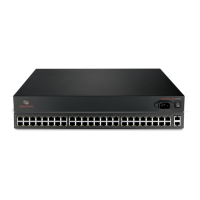Chapter 9: Web Manager Ports Menu Options 89
2. From the pull-down menu select the number of ports on the slave.
3. Enter the First Local Port Number.
4. Enter a global IP address for the cluster in the Local IP address field.
5. Enter the First Local TCP Port Number.
6. Enter the Remote IP address.
7. (Optional) Enter the First Remote TCP Port Number. The default is 7001.
8. Select the communication protocol for all port on the the slave from the Protocol pull-down
menu.
NOTE: Make sure that all ports on the slave are configured with the same connection protocol, either
Console(Telnet) or Console(SSH) under Expert - Ports - Physical Ports.
9. To assign aliases to ports on the slave, perform the following steps.
a. Click the Port Names button.
b. Enter aliases in the Port Name fields.
c. Click OK. The New/Modify Port dialog box appears.
10. Click OK.
11. Click apply changes.
To connect to a port on a slave:
Log into the Web Manager and select the port number from the Applications - Connect - Serial
pull-down menu.
- or -
Use the communication protocol (SSH or Telnet) that is configured for the slave to make a direct
connection to any of its ports. Enter the Local IP address as the IP address. With the ssh command,
you need to enter both the actual TCP port number and the virtual TCP port number as shown in the
following ssh command example.
#
ssh -l username:TCP_port_number_of_the_slave_serial_port \
Local_IP_address -p virtual_TCP_port_number_of_the_slave_port
The telnet command requires only the virtual TCP port number, as shown:
#
telnet Local_IP_address -p virtual_TCP_port_number_of_the_slave_port
Expert - Ports - Ports Status
An administrator can select Expert - Ports - Ports Status to view the status of each serial port.

